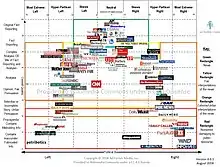Ad Fontes Media
Ad Fontes Media, Inc. is a Colorado-based media watchdog organization primarily known for its Media Bias Chart, which rates media sources in terms of political bias and reliability. The organization was founded in 2018 by patent attorney Vanessa Otero with the goal of combating political polarization and media bias. Ad Fontes Media uses a panel of analysts across the political spectrum to evaluate articles for the Chart.
 | |
| Formation | 2018 |
|---|---|
| Founder | Vanessa Otero |
| Legal status | Active |
| Products | Media Bias Chart |
| Website | www |
History
.jpg.webp)
Ad Fontes Media has its origins in a blog called All Generalizations are False which was written by patent attorney Vanessa Otero from Denver, Colorado. Otero first published the Media Bias Chart, a graphic which helped viewers visualize media bias in the United States, on the blog. The Media Bias Chart became a viral phenomenon on the Imgur image sharing service in December 2016,[1] and Otero founded Ad Fontes Media to serve as the publisher of the chart.[2] One of Otero's reasons for creating the organization was that "many sources people consider to be 'news sources' are actually dominated by analysis and opinion pieces," and that "extreme sources play on people's worst instincts, like fear and tribalism, and take advantage of people's confirmation biases."[3] In an interview with Newsy, she stated that "If people understood that the sources they are consuming are actively making them angrier and polarizing them, then they might choose to consume less of that."[4]
In 2018, Ad Fontes successfully launched a crowdfunding campaign to improve the technology behind the chart, increase the number of analysts, and make the site's methodology more transparent.[4] As of September 2020, the organization had a team of around twenty, most of whom were independent contractors, working as analysts of various news sources.[5][6][7]
Otero chose the name "Ad Fontes" because it is Latin for "to the source"; her method is to go to a media source itself and rate its bias and reliability "by analyzing the source and its actual content."[8][9]
Media Bias Chart

The Media Bias Chart by Ad Fontes Media rates various media sources on two different scales: political bias (left to right) on the horizontal axis and reliability on the vertical axis.[4][10] On the chart, sources are concentrated in an "inverted-U" shape as media sources with a neutral bias are generally reliable in their original fact reporting, while sources with an extreme bias on either side often contain factually inaccurate information and propaganda.[10][11]
Ad Fontes is non-partisan.[12] During the September 2020 media bias project, nearly 1800 individual articles and TV news shows were rated by at least three analysts with different political views (left, right and center). There were 120 analysts, each reviewed about 370 articles and about 17 TV shows. Each analyst rated approximately three articles from each of the over 100 news sources available for viewing on the Chart. As a result, there were nearly 7,000 individual ratings.[5]
Otero sees the Media Bias Chart as an "anchor" that counteracts political polarization in news media, and aspires for Ad Fontes to become a "Consumer Reports for media ratings".[4] She compared low-quality news sources to junk food,[13] and described sources with extreme bias as "very toxic and damaging to the country".[3]
Reception
The chart has been criticized by people on the left and the right. According to Otero, "A lot of people on the left will call us neoliberal shills, and then a bunch of people that are on the right are like, 'Oh, you guys are a bunch of leftists yourselves.'"[14]
In 2018, a Columbia Journalism Review article questioned the thoroughness of the Media Bias Chart and similar initiatives, stating that "the five to 20 stories typically judged on these sites represent but a drop of mainstream news outlets' production".[15]
In 2021, an article on the Association of College and Research Libraries' blog argued that the Media Bias Chart is detrimental to media literacy efforts because it "promotes a false equivalency between left and right, lionizes a political 'center' as being without bias, and reinforces harmful perceptions about what constitutes 'news' in our media ecosystem, and is ignored by anyone that doesn't already hold a comparable view of the media landscape."[16]
News sources that were rated as heavily biased on the Media Bias Chart have been critical of the chart. Alex Jones, the founder of right-wing conspiracy theory site InfoWars, said Ad Fontes' chart represented the "dying dinosaur media's extreme liberal bias" after the chart classified InfoWars as "nonsense damaging to public discourse".[3] InfoWars responded with a chart of their own, putting themselves as "independent" and representing "freedom" while labeling news sources like the Associated Press as "tyranny" and "state-run corporate/foreign influences"; InfoWars's chart was widely criticized by journalists on Twitter.[3][17]
References
- Little, Hannah Byrd (September–October 2018). "Media Literacy: A Moving Target" (PDF). Knowledge Quest. American Association of School Librarians. 48 (1): 18–20. Archived (PDF) from the original on December 25, 2020. Retrieved April 24, 2020.
- Peck, Andrea (June 2019). "A Boulder Lawyer Wants to Help You Become a Smarter News Consumer". 5280. Archived from the original on December 25, 2020. Retrieved May 14, 2020.
- Langlois, Shawn (April 21, 2018). "How biased is your news source? You probably won't agree with this chart". MarketWatch. Retrieved March 30, 2020.
- Thomas, Evan (December 28, 2018). "This Map Can Help Navigate The Partisan Media Landscape". Newsy. Archived from the original on December 25, 2020. Retrieved March 30, 2020.
- "Methodology". Ad Fontes Media. Archived from the original on December 25, 2020. Retrieved September 12, 2020.
- "Become an Analyst for the Media Bias Chart". Ad Fontes Media. Archived from the original on December 25, 2020. Retrieved April 26, 2020.
- "Do You Want to Be an Analyst for the Media Bias Chart?". Ad Fontes Media. December 1, 2018. Archived from the original on March 31, 2019. Retrieved November 3, 2020.
- "The Media Bias Chart®," ad fontes media Inc., 2022. Retrieved 14 May 2022.
- Sheridan, Jake. "Should you trust media bias charts?" Poynter.org, 2 Nov 2021. Retrieved 7 May 2022.
- "Intro to the Media Bias Chart". Ad Fontes Media. Retrieved March 30, 2020.
- Kreidler, Marc (March 19, 2019). "Who Are More Biased: Liberals or Conservatives?". Skeptical Inquirer. Retrieved April 24, 2020.
- Halpern, Sue (December 19, 2018). "The Search for Anti-Conservative Bias on Google". The New Yorker. Archived from the original on December 25, 2020. Retrieved March 30, 2020.
- Jojola, Jeremy (February 10, 2020). "We set up 3 laptops with 3 different newsfeeds. Here's what we've seen so far". 9 News. Archived from the original on December 25, 2020. Retrieved March 31, 2020.
- Sheridan, Jake (October 4, 2021). "Should you trust media bias charts?". Poynter. Archived from the original on February 3, 2021. Retrieved October 30, 2021.
- Wilner, Tamar (January 9, 2018). "We can probably measure media bias. But do we want to?". Columbia Journalism Review. Archived from the original on December 25, 2020. Retrieved March 31, 2020.
- Benjes-Small, Candice and Nathan Elwood (2021). "Complex or clickbait: The problematic Media Bias Chart". ACRLog. Archived from the original on February 23, 2021.
- Tani, Maxwell (December 14, 2016). "Outlandish InfoWars chart attempts to classify media outlets by how 'tyrannical' or 'independent' they are". Business Insider. Archived from the original on December 25, 2020. Retrieved March 30, 2020.